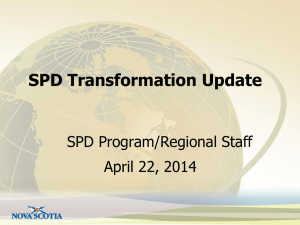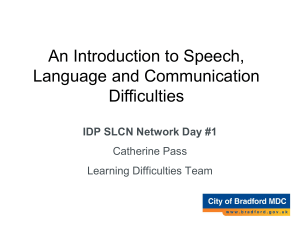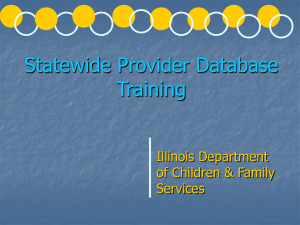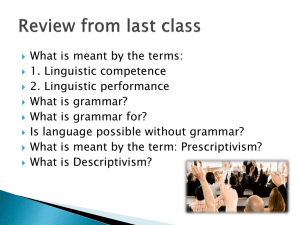Semantic and Pragmatic Difficulties
advertisement
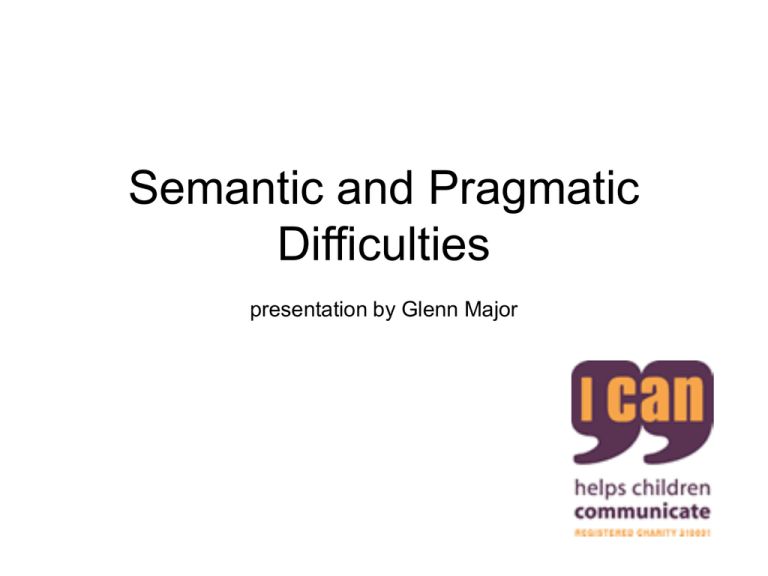
Semantic and Pragmatic Difficulties presentation by Glenn Major speech Form Content Phonology syntax Semantics Language Use Pragmatics Children with Semantic and Pragmatic Difficulties Can have difficulty • Assimilating and assigning meaning to information and experiences • Initiating, maintaining and finishing a conversation • Understanding and relating new (particularly abstract) word meanings and concepts • Interacting with peers and/or adults • Using and interpreting non-verbal language appropriately • Understanding their own or other’s thoughts and/or feelings • Choosing the appropriate style or register of speech • Give the right amount of information • Repairing conversational breakdown • Inferential meaning They may • Use fluent, well-formed sentences • Be verbose with adequate speech articulation • Have a good vocabulary, but not always use words appropriately • Use familiar, learnt scripts (sometimes from videos or cartoons) • Say more than they actually understand • Defined by Rapin and Allen in 1983 as Semantic and Pragmatic Syndrome – severe receptive deficits and expressive deviations • Bishop and Rosenbloom (1987) modified the term to Semantic and Pragmatic Disorder • Shields (1996) compared children with SPD, ASD and SLI. Found SPD and ASD groups the same, SLI better on Theory of Mind tasks • Gagnon (1997) found no differential symptoms between SPD and ASD – questioned use of diagnostic category • Shields (1998) found children with SPD continued to have social difficulties, even after language improved • Rapin and Allen (1998) explained their current position: • SPD occurs most often within autism • Questioned use of SPD diagnosis to avoid upsetting parents with the ‘A’ word • National autistic society does not recognise SPD as diagnostic term • DSM 1V does not recognise SPD • Bishop (1998 onwards) now refers to Pragmatic Language Impairment (PLI): • PLI Pure involves only pragmatic language difficulties • PLI Plus involves pragmatic language difficulties plus autistic traits From Bishop’s [1989] model differentiating SPD, AS and Autism Severe difficulties autism Meaningful verbal communication Semantic Pragmatic difficulties Asperger Syndrome Mild difficulties Mild difficulties Severe difficulties Social relationships and interests 1. 2. 3. 4. • • • The Tetrad of Impairment Problems with social interaction and relationships Problems with communication Lack of flexibility in thinking and behaviour Sensory processing problems In high functioning autism, semantic pragmatic difficulties and Asperger Syndrome, intellectual capacity is within the normal range High functioning autism, semantic pragmatic difficulties and Asperger Syndrome can also include motor clumsiness and problems with handwriting. Also organisational skills Estimates are that 1 in 100 is affected by autistic spectrum disorder The procedure is actually quite simple. First you arrange things into groups. Of course, one pile may be sufficient depending on how much there is to do. If you have to go somewhere else due to lack of facilities, that is the next step; otherwise you are pretty well set. It is important not to overdo things. That is, better to do too few things at once rather than too many. Otherwise complications can arise. A mistake can prove expensive as well. At first the whole procedure will seem complicated. Soon, however, it will become just another facet of life. It is difficult to foresee any end to the necessity for this task in the immediate future, but one can never tell. After the procedure is completed, one arranges the materials into different groups again. Then they can be put into their appropriate places. Eventually, they will be used once more, and the whole cycle will have to be repeated. However, that is part of life • Often things are arranged into groups depending on their colour • Most people have the facilities in their own homes • In the past this procedure took much longer before facilities were mechanised Central Coherence The ability to draw together diverse information to construct higher level meaning in context •Seeing detail rather than the whole •Incoming information is not linked in a meaningful way Difficulties with central coherence can lead to •Cognitive overload •Difficulty with study skills •Insistence on routine •Having to complete the whole routine •Specific interests Rambling and disorganised story linguistic socio-cognitive Poor narrative structure Not being able to prioritise main points History lesson about Henry VIII “draw the ruler” child draws measuring stick linguistic Not understanding ‘ruler’ socio-cognitive Can’t take context into account Theory of Mind Not understanding others’ intentions, thoughts, beliefs, desires, attitudes, and emotions Not understanding that others don’t know what you know A difficulty unique to autism? Link between theory of mind, social interaction and rigidity of thought Not asking for help linguistic socio-cognitive Not knowing question form Using too quiet a voice to be heard – perceives not getting help “he went up there with it” linguistic socio-cognitive Word finding difficulty Not knowing how much information to give Comic Strip Conversations Thinking Saying Interrupting Different colours are used to show feelings and to distinguish between thoughts, feelings, facts and questions. A combination of colours indicates confusion. Conversation Colours GREEN: Good ideas, happy, friendly RED: bad ideas, teasing, anger, unfriendly BLUE: sad, uncomfortable PURPLE: proud YELLOW: frightened BLACK: facts, things that we know ORANGE: questions COMBINATIONS OF COLOURS: confused Executive Functioning Executive Functioning is the way that people monitor and control their actions. Without executive functioning, you have bad organisational skills; you are unable to lay out a logical plan. A broad category including •working memory •planning •cognitive flexibility •inhibitory control Link between theory of mind and executive function Behaviour and lack of inhibitory control How we can help Child jumps in with an answer without thinking linguistic Poor inner language for problem solving socio-cognitive Poor executive functioning, impulsecontrol child pushes another boy to get the drink he wants linguistic socio-cognitive Hasn’t got the language to ask? Can’t inhibit physical reaction Developing Pragmatics • Understanding when & why things go wrong and the need to do something • Raise awareness of and teach the skill or strategy – Highlight the skill – flag up – Observe – Commentary: why this is important – Make the links – doing the skill and outcome – Component parts of the skill – Rules (if possible) – Observe/discuss – different situations • Practise – increasingly less control, increasingly in context • Feedback and evaluate • Praise when right as well as saying when it’s wrong • Lighter touch guidance – prompts Annoyed Scale 8 Stabs hand with compass mad 7 Ankle kicked at football angry 6 Computer switched off during a game cross 5 Someone stares at you and calls you thick annoyed 4 Pushed into girls fed up 3 Horrible food for lunch irritated 2 You can’t find your magazine bothered 1 It’s raining on the way to youth club furious Annoyed scales used in conflict resolution Jim Tom furious 8 8 furious mad 7 7 mad angry 6 6 angry cross 5 5 cross annoyed 4 4 annoyed fed up 3 3 fed up irritated 2 2 irritated bothered 1 1 bothered Group working role cards Leader You are responsible for: •Making sure everyone does their job and helps Making sure the group completes the task on time Reporter You are responsible for •Making notes about what the group does Reporting what the group has done at the end of the task Ideas person You are responsible for: •Thinking up ideas to help the group solve problems Explaining your ideas to the leader Challenger You are responsible for: •Trying to think of what might go wrong Explaining your ideas to the leader Helper You are responsible for •Looking out for who has too much to do and offering help Telling the leader who you have decided to help Coach You are responsible for •Finding ways to encourage others. Making sure everyone works well together Common, correct terminology Scientific or medical term Slang or street language horse stomach boy Equine stomach, abdomen male nag tummy, gut lad, kid, youth, bloke Knockers, boobs, tits, jugs breasts mammary glands gee gee tum tum wee man (Scotland) boobies, titties Playground Lessons ? Euphemisms or baby talk good ?
